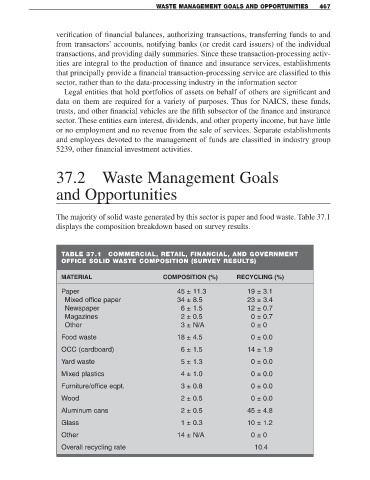Page 489 - Solid Waste Analysis and Minimization a Systems Approach
P. 489
WASTE MANAGEMENT GOALS AND OPPORTUNITIES 467
verification of financial balances, authorizing transactions, transferring funds to and
from transactors’ accounts, notifying banks (or credit card issuers) of the individual
transactions, and providing daily summaries. Since these transaction-processing activ-
ities are integral to the production of finance and insurance services, establishments
that principally provide a financial transaction-processing service are classified to this
sector, rather than to the data-processing industry in the information sector
Legal entities that hold portfolios of assets on behalf of others are significant and
data on them are required for a variety of purposes. Thus for NAICS, these funds,
trusts, and other financial vehicles are the fifth subsector of the finance and insurance
sector. These entities earn interest, dividends, and other property income, but have little
or no employment and no revenue from the sale of services. Separate establishments
and employees devoted to the management of funds are classified in industry group
5239, other financial investment activities.
37.2 Waste Management Goals
and Opportunities
The majority of solid waste generated by this sector is paper and food waste. Table 37.1
displays the composition breakdown based on survey results.
TABLE 37.1 COMMERCIAL, RETAIL, FINANCIAL, AND GOVERNMENT
OFFICE SOLID WASTE COMPOSITION (SURVEY RESULTS)
MATERIAL COMPOSITION (%) RECYCLING (%)
Paper 45 ± 11.3 19 ± 3.1
Mixed office paper 34 ± 8.5 23 ± 3.4
Newspaper 6 ± 1.5 12 ± 0.7
Magazines 2 ± 0.5 0 ± 0.7
Other 3 ± N/A 0 ± 0
Food waste 18 ± 4.5 0 ± 0.0
OCC (cardboard) 6 ± 1.5 14 ± 1.9
Yard waste 5 ± 1.3 0 ± 0.0
Mixed plastics 4 ± 1.0 0 ± 0.0
Furniture/office eqpt. 3 ± 0.8 0 ± 0.0
Wood 2 ± 0.5 0 ± 0.0
Aluminum cans 2 ± 0.5 45 ± 4.8
Glass 1 ± 0.3 10 ± 1.2
Other 14 ± N/A 0 ± 0
Overall recycling rate 10.4

